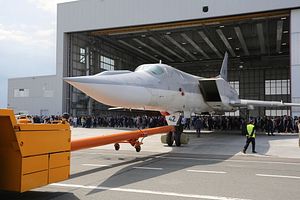The first prototype of Russia’s upgraded Tupolev Tu-22M3M long-range strategic and maritime strike bomber was rolled out at the United Aircraft Corporation (UAC) plant in Kazan on August 16, according to a Russian aerospace and defense company Tupolev statement.
The lead Tu-22M3M is expected to be transferred to the Russian Air Force for ground and flight testing in the coming weeks, following preliminary flight tests. The maiden flight of the first Tu-22M3M is scheduled to take place in the third quarter of 2018, with the first aircraft expected to be delivered to the Russian Air Force by the end of October.
The Tu-22 M3M is a supersonic variable-sweep wing bomber first introduced into service with the Soviet Air Force and Soviet Naval Aviation in the 1970s. Modifications and upgrades include new avionics, digital radio-navigation equipment, a new communications suite, engine, controls and a new updated weapon control system, as well as an updated electronic warfare suite.
“In the process of extensive upgrades the Tupolev-22M3M was equipped with the newest on-board digital radio-electronic equipment made of domestically manufactured components. In particular, the plane boasts new navigation, communication and targeting equipment, new engine and fuel consumption control systems and radio-electronic warfare means,” Tupolev said in a statement.
According to Tupolev, 80 percent of the Tu-22M3M’s avionics equipment has been replaced with parts similar to that of the Tupolev Tu-160M2 long-range supersonic strategic bomber. However, unlike the future variant of the latter, the Tu-22M3M has not been fitted with new engine and will continue to fly with its two Kuznetsov NK-25 turbofan engines.
The new weapons control system enables the Tu-22M3 to launch precision-guided air-launched cruise and ballistic missiles as well as long-range anti-ship missiles. According to unconfirmed reports, the bomber will be able to carry up to four Kh-47M2 Kinzhal (“Dagger”) air-launched ballistic missiles. Furthermore, the Tu-22M3M will be armed with the Kh-32 long-range cruise missile, next to other missiles. As I explained in May:
The Kh-32, an upgraded version of the Raguda Kh-22 long-range anti-ship missile, has been specifically designed to attack U.S. Navy carrier strike groups, but can also be used for land strike missions. It is reportedly designed to climb to the stratosphere (40 kilometers) after launch and then either directly dives at the target or executes a lighter dive and approaches the target flying close to the ground at around 150-200 meters. The Kh-32 purportedly has an operational range of 1,000 kilometers and can reach top speeds of over Mach 4 in its terminal phase.
The Russian Ministry of Defense intends to upgrade up to 30 out of a fleet of approximately 60 Tu22s to the more advanced Tu-22M3M variant.

































